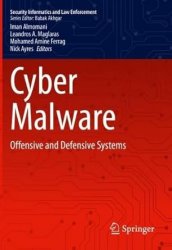Cyber Malware: Offensive and Defensive Systems
- Добавил: literator
- Дата: 9-11-2023, 09:01
- Комментариев: 0
 Название: Cyber Malware: Offensive and Defensive Systems
Название: Cyber Malware: Offensive and Defensive SystemsАвтор: Iman Almomani, Leandros A. Maglaras, Mohamed Amine Ferrag
Издательство: Springer
Год: 2024
Страниц: 310
Язык: английский
Формат: pdf (true), epub
Размер: 24.7 MB
This book provides the foundational aspects of malware attack vectors and appropriate defense mechanisms against malware. The book equips readers with the necessary knowledge and techniques to successfully lower the risk against emergent malware attacks. Topics cover protections against malware using machine learning algorithms, Blockchain and AI technologies, smart AI-based applications, automated detection-based AI tools, forensics tools, and much more. The authors discuss theoretical, technical, and practical issues related to cyber malware attacks and defense, making it ideal reading material for students, researchers, and developers.
Many aspects motivated the decision toward the creation of this book. Malicious actors frequently employ malware in their campaigns. Gaining and maintaining control of assets, evading and deceiving defenses, and carrying out post-compromise actions all require this fundamental capability. The book has two clear goals. The first is to bring in front important security problems that arise in the advent of malware, and the second is to highlight a variety of possible solution approaches that might be able to address them. Specialists and experts present their significant efforts to fulfill these goals.
In the last decade, researchers have shifted to Deep Learning in order to overcome the aforementioned limitations of conventional Machine Learning approaches. Simply speaking, Deep Learning techniques can be defined as as a neural network with a large number of parameters and layers. In fact, they are a subclass of Machine Learning algorithms that use many nonlinear information processing layers for supervised or unsupervised feature extraction, transformation, and classification, as well as pattern analysis. Deep Learning has widely been investigated in language processing and have been extended to various fields, including cybersecurity, and more specifically in the context of malware analysis and detection. In fact, deep learning has shown an impressive potential for detecting malware. Indeed, it can identify patterns in data that are too complex for traditional Machine Learning methods, making it more accurate and efficient. Additionally, Deep Learning can be used to detect new and unknown types of malware, making it an essential tool in the fight against cyberattacks. Indeed, employing deep learning techniques in the context of malware analysis and detection has various advantages, such as:
• Automatic feature learning from data is possible with deep learning, which can improve the detection accuracy.
• Deep Learning can learn from data with different levels of abstraction, which can improve detection of more sophisticated malware.
• Deep Learning can identify patterns that are too difficult for humans to discern.
• Deep Learning can be used with unsupervised learning methods to detect previously unknown malware.
Contents:
Скачать Cyber Malware: Offensive and Defensive Systems
Внимание
Уважаемый посетитель, Вы зашли на сайт как незарегистрированный пользователь.
Мы рекомендуем Вам зарегистрироваться либо войти на сайт под своим именем.
Уважаемый посетитель, Вы зашли на сайт как незарегистрированный пользователь.
Мы рекомендуем Вам зарегистрироваться либо войти на сайт под своим именем.
Информация
Посетители, находящиеся в группе Гости, не могут оставлять комментарии к данной публикации.
Посетители, находящиеся в группе Гости, не могут оставлять комментарии к данной публикации.

